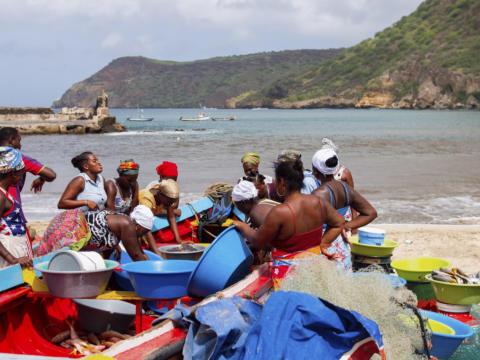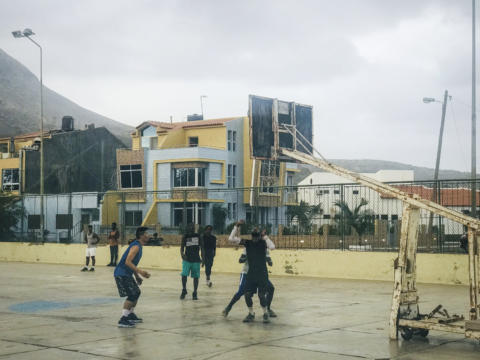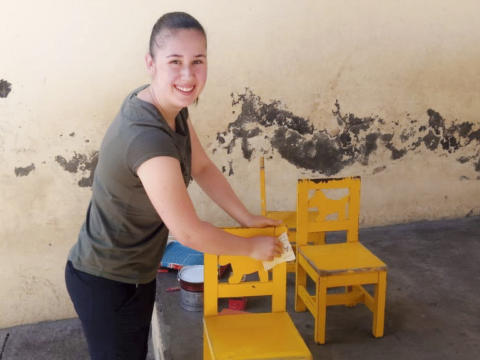Only 600€ per week!
Turtle Conservation
Tarrafal - Cape Verde
Join us in our program to conserve sea turtles on the Islands of Cape Verde and directly involve in making a difference to save these species from extinction.
Your participation on this program will have a long term impact on the marine ecosystem with hands-on work with wild nesting sea turtles. You will get the chance to travel to an exotic destination, work on beaches famous for its splendid scenery and at the same time gain fieldwork experience in sea turtle conservation.
Program Description
The Cape Verden island’s beaches are one of the most visited sites by the Loggerhead sea turtle (Caretta caretta) for nesting during the months of July to October and extending until December. These species play a critical link in the marine ecosystems and in the marine food chain by maintaining the health of sea grass and coral reef ecosystems that provide food and home for a wide variety of other marine life.
The greatest threat to these sea turtles’ survival is loss of nesting habitat due to coastal development, predation of nests, and human disturbances (such as coastal lighting and housing developments) that cause disorientations during the emergence of hatchlings. Other major threats include incidental capture in longline fishing, shrimp trawling and pollution. Incidental capture in fisheries is thought to have played a significant role in the recent population declines observed for the loggerhead.
Through this program you and members of the local community will be working to ensure protection of the female sea turtles –
- by patrolling the beaches at night during the nesting season,
- transporting the eggs into a safe hatchery to protect them from animals and humans,
- educating the community and the children about the importance of the turtles in the marine ecosystem,
- working with the government to improve regulations,
- and also feeding, cleaning, and taking care of hatchlings until they are fit and strong enough to be released into the ocean.
We aim to empower the local young community to take action by protecting nesting females, through direct beach protection, as well as grassroots education at local schools. As critical part of the team, you will have the opportunity to directly contribute to the conservation of Loggerhead sea turtle species, and ultimately help to build a more sustainable Island.
The program encompasses,
- patrolling beaches (night and morning) to monitor nesting and deter hunting,
- data collection,
- operation of hatcheries,
- education and outreach activities and
- beach clean-ups.
The work is undertaken by local field assistants and participants. Although there is a wide scope of activities within the project, protection of nesting turtles continues to be the main focus and this can be stressful and tiring, but ultimately highly rewarding.
As a participant on this program, your primary role will be to patrol the beaches at night with other assistants in order to deter hunters and ensure the turtle can nest safely. During patrols, you will also assist with important fieldwork activities, including tagging and measuring turtles, and relocation and excavation of nests. You may also get involved with other aspects of the outreach activities. Through this experience you’ll learn about sea turtle conservation techniques and will have the opportunity to make a difference to the survival of marine turtles.
Living under these conditions could be challenging, tiring, and will include work both at night and during the day. A good level of fitness and physical and mental energy is required as patrols are long (possibly all night), conducted on foot and may be as long as 5 to 6 km.
The normal nesting season is from July until December with hatchlings being born from mid-August until late December. The program is located at Ribera Das Pratas. You will be based in field camps with very basic accommodation facilities during night patrols as there is no electric power at the beach. This opportunity will not only provide you with good experience of turtle conservation techniques, but also will allow you to make a real difference to the survival of marine turtles. Your participation on this program will be directly saving numerous nesting sea turtles and hatchlings.
Aims & Objectives
To protect and conserve the loggerhead sea turtles and their nesting habitat by various means such as providing protective hatcheries, treating injured or wounded turtles, conserving their beaches from pollution, and collection of data to better understand the species and their habitats.
Schedule
Monday to Friday
During June to December
1830 to 1900 – Clean the beach
1900 to 1930 – Orientation for the day with station positions along the beach
2030 to 2230 – Shift 1 – Night patrol
2230 to 0030 – Rest
0030 to 0200 – Night Patrol
0200 to 0400 – Night Patrol
0400 to 0600 – Patrol to clean up the beach
During January to May
0900 – Travel to the beach
0930 to 1000 – Orientation for the day
1000 to 12:00 – You will be doing one or two of the following tasks cleaning and maintenance of the turtle project site, tree plantation at the beach or awareness program at the local school or designing pamphlets or distributing printed pamphlets or making awareness wooden boards and placing it at the beach, and promoting the importance of sea turtles in the villages around the beach through paintings and drawings and beach clean-up activities.
1200 to 1400 – Lunch at the centre
1400 to 1430 – Travel to beach
1430 to 1630 – Continue with hour activities planned for the day
1630 to 1800 – Join the locals to play beach football or volleyball.
***This schedule can be changed and/or amended depending on weather conditions, local conditions and unforeseen circumstances.***
Note: This schedule can be changed and/or amended depending on weather conditions, local conditions and unforeseen circumstances.
Participant Criteria & Requirements
Standard Requirements
Minimum age: –
Maximum age: –
Minimum English level: Basic
CRB required: On Signup
Passport copy required: On Signup
Resume copy required: No
Required qualification: None
Additional Requirements
- Yellow fever vaccination is a mandatory requirement for all participants arriving in Cape Verde.
- Participants below 18 are required to provide parental consent letters and participants above 65 should have the medical clearance.
- Understand written and spoken English
- Good level of physical fitness
- High level of energy and flexibility
- Able to cope with physically challenging conditions (camping, long walks, late nights, hot weather, insects)
- Ability to work and live with people of different backgrounds and nationalities
Additional Equipment
No Additional equipment required.
Location
The city is named after the indigenous plant Tarrafe, (Tamarix senegalensis). Also called Mangui or Mangue, it is situated on the northern part of the island of Santiago. A fishing port situated on the northwestern coast and also is a municipality.
About the Accommodation
You can expect to share a room on single gender basis. The bathroom is shared and western toilets are available.
Food Arrangements
The meals will contain a mix of local and various types of Western food.
Facilities
There are ATMs, mini marts, some shops and restaurants available in the city center.
Activities & Events
No scheduled activities outside the program.
Sights & Surroundings
- Tarrafal beach
Transportation
From this location we do not provide free transport to other locations.
Quick Facts
Name: Republic of Cabo Verde
Population: 532,913 (2016)
Capital: Praia
Language: Portuguese, Cape Verdean Creole
Currency: Cape Verdean Escudo (CVE)
Time zone: CVT (UTC-1)
Country Information
The beautiful islands of the Cape Verde were initially uninhabited until it was discovered by the Portuguese in the 15th century. The country flourished during the 16th and the 17th centuries due to the Atlantic slave trade. But with the decline of the slave trade in the 19th century, the country experienced an economic crisis. Yet the location of the island made it survive as it became a significant commercial center in the 19th century as the location was perfect for re-supply of the ships. In the present day context, the economy of the country is mostly relying on the services provided by the country targeting the growing tourism industry.
Climate
Cape Verde has a mild climate compared to the mainland of Africa with an average high temperature of about 26 °C during February and 31 °C in September. The country has an irregular rain pattern in the months between August and October and it is in September that the country experiences its maximum rainfall. The country can boast about the rich vegetation and the forests that provides a rainforest habitat although the close proximity to the Sahara is makes most islands with no mountains mostly dry. The islands as initially were isolated, the existence of a number of endemic species mostly the birds and reptiles can be seen although the existence is threatened by the human developments.
Culture
As the country was discovered by the Portuguese, the culture is immensely influenced by them as the rural Portuguese practices are displayed in the social and cultural patterns of the country. The closeness to the church activities and the football games act as way of interaction between the locals for entertainment.
Transportation
By bus
For travelling within the islands, the most famous transportation is the minibuses which are known as “Yasi” which can accommodate around 12 to 14 passengers. In addition, the modified pickup truck and the cabs which are sometimes covered provide the transport facilities for shorter distances and in rural areas.
By Taxi
Taxis can mostly be found in the cities of Praia and Assomada, and they have unique colored taxis in these two cities, where taxis painted in beige are based in Praia and the taxis painted in white are based in Assomada. The taxis sometimes have a meter fixed to it although they hardly use it as the rates which are usually accepted are cheaper than the ones the metered taxis would count.





